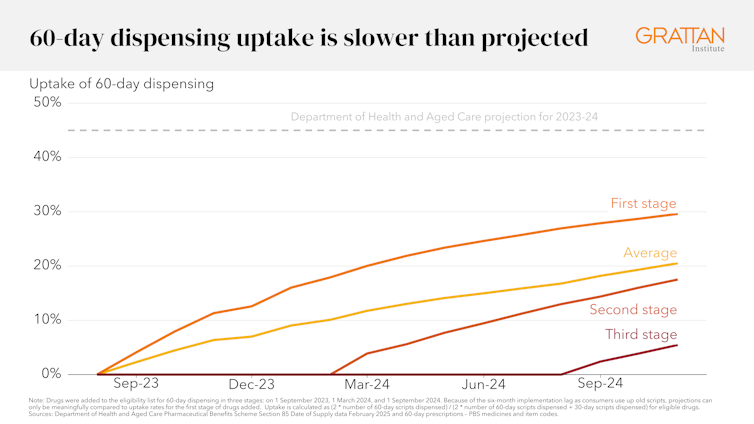Labor has dedicated A$690 million over 4 years to lower the utmost price of medicines on the Pharmaceutical Advantages Scheme (PBS) to $25. The Coalition has matched the promise, which is estimated to save lots of Australians $200 million a 12 months.
However customers may save much more if an current coverage met its potential.
In 2023, the federal authorities launched 60-day prescribing. This meant customers may get twice as many capsules per script, with fewer journeys to the pharmacist (and to the physician for a script).
The federal government introduced that customers would save as much as $190 a 12 months for a single medication, and as much as $46 for a concession card holder, in comparison with the prices of a 30-day script.
However after a tricky struggle to get this coverage, it isn’t dwelling as much as its promise.
A tough-won coverage
It took political braveness, and authorities spending, to get this modification.
Information on political donations present pharmaceutical pursuits make up the huge bulk of donations from the well being sector. The Pharmacy Guild, which represents pharmacy house owners, spent essentially the most by far. These donations are an try and wield affect behind the scenes. When that fails, the guild isn’t afraid to assault governments in public.
The federal authorities stared down a histrionic scare marketing campaign in opposition to 60-day prescribing. The guild claimed pharmacies would shut as a result of decreased dishing out charges. It additionally claimed medicines would run out, and youngsters would overdose as a result of tablet hoarding.

Lukas Coch/AAP
The federal government pushed by way of the coverage, however straight compensated rural pharmacies with ongoing funds value $20 million a 12 months.
The federal government additionally introduced ahead negotiation of the eighth Group Pharmacy Settlement, which units how a lot the federal government pays pharmacists for dishing out, medicine administration, and different providers. The settlement was signed final 12 months and added $3 billion in new spending.
An extended look ahead to longer scripts
In any case that battle and value, our evaluation of PBS knowledge reveals the uptake of longer scripts has been painfully gradual.
About 300 medication for power well being situations have been added to the eligibility listing in three phases.
For the primary stage of medicines, the 60-day choice grew to become accessible in late 2023. This included frequent drugs akin to statins for prime ldl cholesterol, perindopril for hypertension, and alendronate for osteoporosis.
Greater than a 12 months later, in November 2024, solely 30% of eligible stage one medicines allotted had been from a 60-day script.

That’s properly in need of expectations. The Division of Well being and Aged Care predicted 60-day uptake would attain 45% in 2023–24, 58% in 2024–25, and 63% in 2026–27, if totally applied.
Throughout all medicines eligible for 60-day prescribing, together with these added within the second and third phases, simply 21% of medicines allotted had been from a 60-day script.
Even at these low charges, we estimate the coverage has saved customers greater than $110 million to this point. Greater uptake, nearer to the charges the division predicted, would imply much more financial savings.
Tens of millions of individuals are lacking out. In 2024, there have been about 28 million 30-day scripts for statins, in comparison with about 5 million 60-day scripts. If half of those sufferers had a 60-day script, they might have saved an additional $27 million a 12 months.
If half of all eligible medicines had been allotted for 60 days, we estimate sufferers would have saved an additional $310 million a 12 months. That’s greater than the $200 million in anticipated financial savings from the $25 medicines promise.
And whereas the federal government spends cash on the $25 medicines coverage, it saves cash from 60-day scripts, by paying pharmacists fewer dishing out charges.
We estimate the federal government has already saved $141 million from 60-day prescribing. It may save an additional $297 million a 12 months if uptake elevated to 50%.
So why aren’t extra GPs writing longer scripts?
Regardless of the Pharmacy Guild’s efforts to undermine the reform, low uptake is extra about medical doctors than pharmacists: the GP who writes the script determines its period, not the pharmacist.
Dangers for sufferers aren’t the issue. Whereas 60-day prescribing gained’t be proper for all sufferers, specialists chosen the eligible medication as a result of prescribing them for 60 days is normally acceptable and secure.
Whereas there’s some variation in 60-day prescribing charges for various medicines, it’s low throughout the board. That implies the issue isn’t about GPs being rather more cautious with some medication than with others.

Stephen Barnes/Shutterstock
The wrongdoer might be inertia. GP observe software program generates default prescriptions when a affected person has had a drug earlier than. With most individuals nonetheless getting 30-day prescriptions, that would be the default for many repeat scripts. And plenty of sufferers won’t bear in mind the brand new 60-day choice is on the market.
It’s time to get outcomes
With cost-of-living and well being system pressures by no means removed from the headlines, making progress on 60-day prescribing must be a precedence.
The advantages for affected person and authorities budgets are apparent. However the advantages of releasing up time for busy clinicians shouldn’t be neglected. Longer scripts means much less GP time to put in writing them, and fewer pharmacist time to fill them.
As Australia will get older and sicker, the necessity for GP and pharmacist care grows, and there are extreme major care shortages in lots of elements of the nation.
Each second of GP time that may be freed up for analysis, remedy, and to assist sufferers handle their situations is valuable.
There’s additionally good proof pharmacists can present cost-effective medicine critiques, power illness administration recommendation and different providers. Shifting their time from retail to providers is a good way to take strain off the well being system.
So what will be carried out?
Happily, there are some straightforward shortcuts to longer scripts.
Suppliers of GP software program ought to make 60-day prescribing the default for related medicines.
The Royal Australian School of Normal Practitioners, the skilled physique for GPs, ought to proceed to encourage GPs to put in writing longer scripts.
Main Well being Networks, the regional our bodies chargeable for bettering major care, ought to inform GPs how they evaluate with their friends, giving a nudge to GPs with low charges of 60-day prescribing.
Lastly, the federal authorities and client teams ought to run campaigns to tell sufferers about their choices.
Longer scripts are a triple win: financial savings on medicines for sufferers, funds financial savings for the federal government, and extra time for GPs and pharmacists. Few reforms tick all these bins, so it’s necessary this one makes its means from good coverage to straightforward observe.

